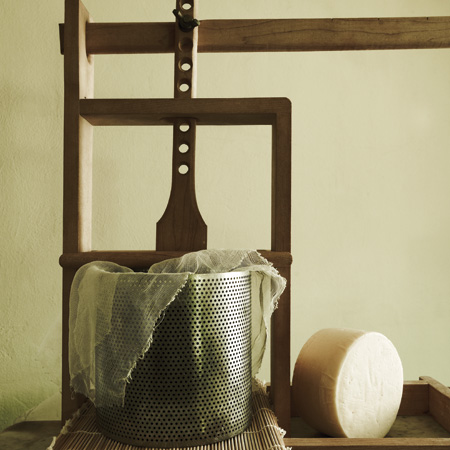Farmhouse Cheddar

Ingredients
2 gallons fresh whole cow’s milk1 packet direct-set mesophilic starter
½ tsp. liquid vegetarian rennet, diluted in 1 cup cool, unchlorinated water
1 Tbsp. cheese salt
Chile flakes, dried herbs or seasoning for flavor (optional)
1/3 lb. cheese wax
¼ cup vinegar
Preparation
• Over low heat, bring the milk to 90 degrees in a large nonreactive pot.
• Add the starter and stir thoroughly. Cover the milk and allow it to ripen for 45 minutes.
• Add the diluted rennet and stir gently with an up-and-down motion for 1 minute. Cover and let set on the stove at the same low heat for 45 minutes, or until the curd gives a clean break when you cut it.
• Cut the curd into ½-inch cubes, using a knife that reaches to the bottom of the pot.
• Slowly heat the curds to 100 degrees, raising the temperature by no more than 2 degrees every 5 minutes (this stage should take 30 minutes). Stir gently to keep the curds from matting. They will shrink noticeably as the heating continues.
• Cover the pot and let the curds set for 5 minutes. Pour the curds into a cheesecloth-lined colander. Tie the corners of the cheesecloth into a knot, and hang the bag in a convenient, relatively warm spot to drain for 1 hour.
• Place the curds in a bowl, and break them up gently with your fingers into walnut-sized pieces. Mix in the salt, and if you are including herbs or spices, add these now, too. (You now have squeaky cheese curds, which may be eaten fresh.)
• Firmly pack the curds into a 2-pound mold lined with cheesecloth, then neatly fold the cheesecloth over the top. Using a cheese press, apply 10 pounds of pressure for 10 minutes.
• Remove the cheese from the mold and gently peel away the cheesecloth. Turn the cheese over, re-dress it and press at 20 pounds for 10 minutes.
• Repeat the process, but press at 50 pounds for 12 hours, this time pressing just one side.
• Remove the cheese from the mold and carefully peel away the cheesecloth. Air-dry the cheese at room temperature on a wooden board until a nice rind has developed and the surface is quite dry, about 2 to 4 days. Turn the cheese several times a day to keep moisture evenly distributed.
• Let the cheese cool in the refrigerator for 2 hours prior to waxing so the wax will adhere better.
• Wipe the cheese with a cloth dampened lightly with vinegar to prevent molding, and let it dry.
• Melt the wax in a double boiler on a stovetop vented with a fan. (Wax vapors are highly flammable, so be careful.)
• Heat the wax to 225 degrees, being careful not to let it get hotter than 240 degrees or it will reach flash point. With a natural bristled brush, paint the melted wax onto the cheese in smooth, even coats. Allow it to dry several seconds on one side, then flip it over and paint the second side. Repeat to apply two coats. The second coat can be cooler – as low as 170 degrees – to avoid melting the first.
• Age the cheese for at least 1 month at 45 to 55 degrees, turning daily.



